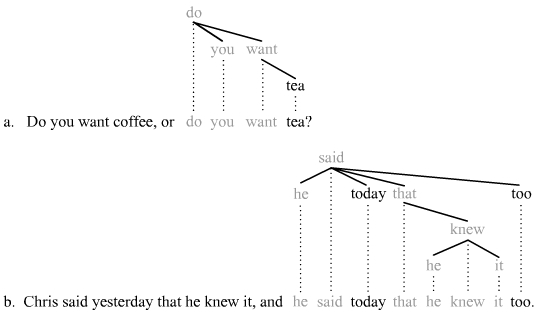|
Stripping (linguistics)
Stripping or bare argument ellipsis is an ellipsis mechanism that elides everything from a clause except one constituent. It occurs exclusively in the non-initial conjuncts of coordinate structures. One prominent analysis of stripping sees it as a particular manifestation of the gapping mechanism, the difference between stripping and gapping lies merely with the number of remnants left behind by ellipsis: gapping leaves two (and sometimes more) constituents behind, whereas stripping leaves just one. Stripping occurs in many languages and is a frequent occurrence in colloquial conversation. As with many other ellipsis mechanisms, stripping challenges theories of syntax in part because the elided material often fails to qualify as a constituent in a straightforward manner. Examples The following examples illustrate standard cases of stripping. The elided material is indicated using smaller font size and subscripts. ::Susan works at night, and Bill works at night too. ::Why did Sam ca ... [...More Info...] [...Related Items...] OR: [Wikipedia] [Google] [Baidu] |
Ellipsis (linguistics)
In linguistics, ellipsis (from el, ἔλλειψις, ''élleipsis'' 'omission') or an elliptical construction is the omission from a clause of one or more words that are nevertheless understood in the context of the remaining elements. There are numerous distinct types of ellipsis acknowledged in theoretical syntax. Theoretical accounts of ellipsis seek to explain its syntactic and semantic factors, the means by which the elided elements are recovered, and the status of the elided elements. Theoretical accounts of ellipsis can vary greatly depending in part upon whether a constituency-based or a dependency-based theory of syntactic structure is pursued. Background Varieties of ellipsis have long formed a basis of linguistic theory that addresses basic questions of form–meaning correspondence: in particular, how the usual mechanisms of grasping a meaning from a form may be bypassed or supplanted via elliptical structures. In generative linguistics, the term ''ellipsis'' has ... [...More Info...] [...Related Items...] OR: [Wikipedia] [Google] [Baidu] |
Constituent (linguistics)
In syntactic analysis, a constituent is a word or a group of words that function as a single unit within a hierarchical structure. The constituent structure of sentences is identified using ''tests for constituents''. These tests apply to a portion of a sentence, and the results provide evidence about the constituent structure of the sentence. Many constituents are phrases. A phrase is a sequence of one or more words (in some theories two or more) built around a head lexical item and working as a unit within a sentence. A word sequence is shown to be a phrase/constituent if it exhibits one or more of the behaviors discussed below. The analysis of constituent structure is associated mainly with phrase structure grammars, although dependency grammars also allow sentence structure to be broken down into constituent parts. Tests for constituents in English Tests for constituents are diagnostics used to identify sentence structure. There are numerous tests for constituents that are c ... [...More Info...] [...Related Items...] OR: [Wikipedia] [Google] [Baidu] |
Coordination (linguistics)
In linguistics, coordination is a complex syntactic structure that links together two or more elements; these elements are called ''conjuncts'' or ''conjoins''. The presence of coordination is often signaled by the appearance of a coordinator ( coordinating conjunction), e.g. ''and'', ''or'', ''but'' (in English). The totality of coordinator(s) and conjuncts forming an instance of coordination is called a coordinate structure. The unique properties of coordinate structures have motivated theoretical syntax to draw a broad distinction between coordination and subordination. It is also one of the many constituency tests in linguistics. Coordination is one of the most studied fields in theoretical syntax, but despite decades of intensive examination, theoretical accounts differ significantly and there is no consensus on the best analysis. Coordinators A ''coordinator'' or a coordinating conjunction, often appears between the conjuncts, usually at least between the penultimate and ... [...More Info...] [...Related Items...] OR: [Wikipedia] [Google] [Baidu] |
Gapping
In linguistics, gapping is a type of ellipsis that occurs in the non-initial conjuncts of coordinate structures. Gapping usually elides minimally a finite verb and further any non-finite verbs that are present. This material is "gapped" from the non-initial conjuncts of a coordinate structure. Gapping exists in many languages, but by no means in all of them, and gapping has been studied extensively and is therefore one of the more understood ellipsis mechanisms. Stripping is viewed as a particular manifestation of the gapping mechanism where just one remnant (instead of two or more) appears in the gapped/stripped conjunct. Basic examples Canonical examples of gapping have a true "gap", which means the elided material appears medially in the non-initial conjuncts, with a remnant to its left and a remnant to its right. The elided material of gapping in all the examples below is indicated with subscripts and a smaller font: ::Some ate bread, and others ate rice. ::Fred likes to pet t ... [...More Info...] [...Related Items...] OR: [Wikipedia] [Google] [Baidu] |
Disjunctive Pronoun
A disjunctive pronoun is a stressed form of a personal pronoun reserved for use in isolation or in certain syntactic contexts. Examples and usage Disjunctive pronominal forms are typically found in the following contexts. The examples are taken from French, which uses the disjunctive first person singular pronoun ''moi''. The (sometimes colloquial) English translations illustrate similar uses of ''me'' as a disjunctive form. *in syntactically unintegrated disjunct (or "dislocated") positions :''Les autres s'en vont, mais moi, je reste.'' :: The others are leaving, but me, I'm staying. *in elliptical constructions (often "sentence fragments") with no verb (e.g. short answers) :''Qui veut du gâteau ? Moi.'' :: Who wants cake? Me. (cf. "I do") :''Il est plus âgé que moi.'' :: He is older than me. (cf. "I am") *in the main clause of a cleft sentence :''C'est moi que vous cherchez.'' :: It's me that you're looking for. Disjunctive pronouns are often semantically restricted. For e ... [...More Info...] [...Related Items...] OR: [Wikipedia] [Google] [Baidu] |
Constituency Grammar
The term phrase structure grammar was originally introduced by Noam Chomsky as the term for grammar studied previously by Emil Post and Axel Thue (Post canonical systems). Some authors, however, reserve the term for more restricted grammars in the Chomsky hierarchy: context-sensitive grammars or context-free grammars. In a broader sense, phrase structure grammars are also known as ''constituency grammars''. The defining trait of phrase structure grammars is thus their adherence to the constituency relation, as opposed to the dependency relation of dependency grammars. Constituency relation In linguistics, phrase structure grammars are all those grammars that are based on the constituency relation, as opposed to the dependency relation associated with dependency grammars; hence, phrase structure grammars are also known as constituency grammars. Any of several related theories for the parsing of natural language qualify as constituency grammars, and most of them have been developed ... [...More Info...] [...Related Items...] OR: [Wikipedia] [Google] [Baidu] |
Phrase Structure Grammar
The term phrase structure grammar was originally introduced by Noam Chomsky as the term for grammar studied previously by Emil Post and Axel Thue ( Post canonical systems). Some authors, however, reserve the term for more restricted grammars in the Chomsky hierarchy: context-sensitive grammars or context-free grammars. In a broader sense, phrase structure grammars are also known as ''constituency grammars''. The defining trait of phrase structure grammars is thus their adherence to the constituency relation, as opposed to the dependency relation of dependency grammars. Constituency relation In linguistics, phrase structure grammars are all those grammars that are based on the constituency relation, as opposed to the dependency relation associated with dependency grammars; hence, phrase structure grammars are also known as constituency grammars. Any of several related theories for the parsing of natural language qualify as constituency grammars, and most of them have been de ... [...More Info...] [...Related Items...] OR: [Wikipedia] [Google] [Baidu] |
Dependency Grammar
Dependency grammar (DG) is a class of modern grammatical theories that are all based on the dependency relation (as opposed to the ''constituency relation'' of phrase structure) and that can be traced back primarily to the work of Lucien Tesnière. Dependency is the notion that linguistic units, e.g. words, are connected to each other by directed links. The (finite) verb is taken to be the structural center of clause structure. All other syntactic units (words) are either directly or indirectly connected to the verb in terms of the directed links, which are called ''dependencies''. Dependency grammar differs from phrase structure grammar in that while it can identify phrases it tends to overlook phrasal nodes. A dependency structure is determined by the relation between a word (a head) and its dependents. Dependency structures are flatter than phrase structures in part because they lack a finite verb phrase constituent, and they are thus well suited for the analysis of languag ... [...More Info...] [...Related Items...] OR: [Wikipedia] [Google] [Baidu] |
X-bar Theory
In linguistics, X-bar theory is a model of phrase-structure grammar and a theory of syntactic category formation that was first proposed by Noam Chomsky in 1970Chomsky, Noam (1970). Remarks on Nominalization. In: R. Jacobs and P. Rosenbaum (eds.) ''Reading in English Transformational Grammar'', 184–221. Waltham: Ginn. and further developed by Ray Jackendoff (1974, 1977a, 1977bJackendoff, Ray (1977b) Constraints on Phrase Structure Rules, in P. W. Culicover, T. Wasow & A. Akmajian (eds.), ''Formal Syntax'', Academic Press, New York, pp. 249–83.), along the lines of the theory of generative grammar put forth in the 1950s by Chomsky. It attempts to capture the structure of phrasal category, phrasal categories with a single uniform structure called the X-bar schema, basing itself on the assumption that any phrase in natural language is an XP (X phrase) that is headed by a given syntactic category X. It played a significant role in resolving issues that phrase structure rules had, r ... [...More Info...] [...Related Items...] OR: [Wikipedia] [Google] [Baidu] |
Catena (linguistics)
In linguistics, a catena (English pronunciation: , plural catenas or catenae; from Latin for "chain") is a unit of syntax and morphology, closely associated with dependency grammars. It is a more flexible and inclusive unit than the constituent and may therefore be better suited than the constituent to serve as the fundamental unit of syntactic and morphosyntactic analysis. The catena has served as the basis for the analysis of a number of phenomena of syntax, such as idiosyncratic meaning, ellipsis mechanisms (e.g. gapping, stripping, VP-ellipsis, pseudogapping, sluicing, answer ellipsis, comparative deletion), predicate-argument structures, and discontinuities ( topicalization, wh-fronting, scrambling, extraposition, etc.). The catena concept has also been taken as the basis for a theory of morphosyntax, i.e. for the extension of dependencies into words; dependencies are acknowledged between the morphs that constitute words. While the catena concept has been appli ... [...More Info...] [...Related Items...] OR: [Wikipedia] [Google] [Baidu] |




.png)
.jpg)
.png)
